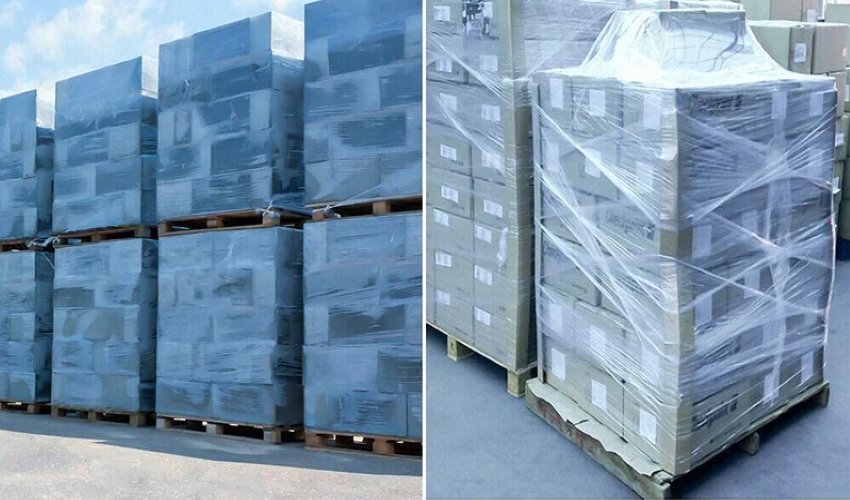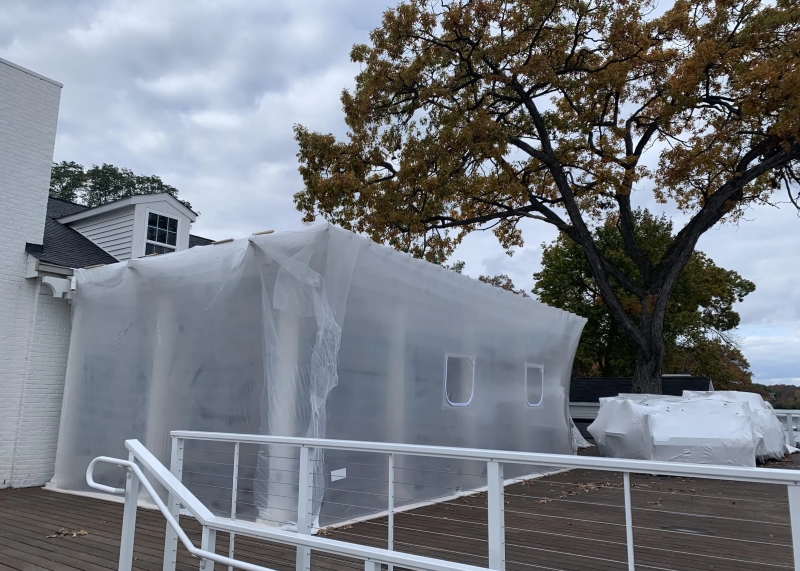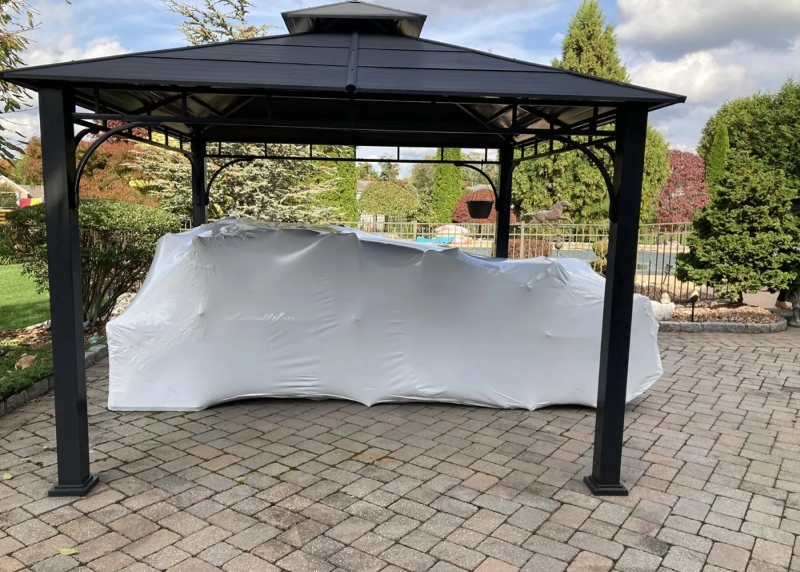
Using outdoor stretch wrap is essential for protecting products stored outside, especially against harsh weather elements and harmful UV damage. This type of stretch wrap provides a reliable barrier that keeps items safe from rain, snow, and sunlight, ensuring their longevity and integrity. Common applications of outdoor stretch wrap can be found across various industries, including construction, landscaping, and storage solutions. It is particularly useful for bundling materials, securing pallets, and wrapping outdoor furniture. In this guide, readers can expect to learn about the different types of outdoor stretch wrap, their key features, the benefits they offer, and best practices for effective application and usage to maximize protection in outdoor environments. Outdoor stretch wrap protects products from UV damage, weather, and photodegradation, ensuring durability in extended outdoor storage.
Weatherproof outdoor stretch wrap is designed to provide superior protection against various environmental elements. This type of outdoor stretch wrap incorporates advanced materials and technologies that enhance its resistance to rain, snow, and extreme temperatures.

The following features contribute to its weatherproof qualities:
Weatherproof outdoor stretch wrap is essential in various industries and situations, including:
The use of weatherproof outdoor stretch wrap provides significant advantages in harsh weather conditions. Key benefits include:
By incorporating weatherproof outdoor stretch wrap into your storage and protection strategies, you can ensure that your products remain safe and intact, regardless of the weather conditions. At PWP Stretch Film, we prioritize the quality and effectiveness of our outdoor stretch wrap, providing you with the best options for your specific needs.
Waterproof outdoor stretch wrap is specifically engineered to provide an effective barrier against moisture, ensuring that goods remain protected from water damage. This outdoor stretch wrap utilizes advanced materials and sealing techniques to create a protective layer that prevents rain, humidity, and other forms of moisture from penetrating the wrap. The waterproof qualities help in several key ways:
Waterproof outdoor stretch wrap is commonly used across several scenarios, including:
By choosing waterproof outdoor stretch wrap from PWP Stretch Film, you can ensure that your products are protected from moisture and other environmental factors, ultimately enhancing their longevity and usability.
Heavy duty outdoor stretch wrap is a robust packaging solution designed to provide exceptional strength and durability. This type of outdoor stretch wrap is characterized by its enhanced thickness and tensile strength, making it ideal for withstanding rough handling and challenging outdoor conditions. Key features of heavy duty outdoor stretch wrap include:
Heavy duty outdoor stretch wrap is widely utilized across various sectors, particularly in situations where enhanced protection is necessary. Some ideal uses include:
The advantages of using outdoor stretch wrap heavy duty are substantial, particularly in demanding environments. These include:
By selecting heavy duty outdoor stretch wrap from PWP Stretch Film, you can ensure that your products are not only well-protected but also ready to withstand the rigors of outdoor environments.
The durability of outdoor stretch wrap is influenced by several factors that can significantly affect its performance in outdoor conditions.

Key elements to consider include:
Understanding these factors is crucial for choosing the right outdoor stretch wrap to ensure your items remain protected over time.
The expected lifespan of outdoor stretch wrap can vary significantly based on the type of wrap used. Here’s a breakdown:
By choosing UV-stabilized options, I ensure that the stretch wrap maintains its protective qualities for a longer duration.
To extend the outdoor lifespan of stretch wrap, consider implementing the following practical tips:
By following these tips, I can help ensure that my outdoor stretch wrap remains effective, providing robust protection for my items against the elements.
When selecting the best outdoor stretch wrap, several key qualities are essential to ensure effective protection against various weather conditions. I always consider the following factors:
By focusing on these qualities, I can select an outdoor stretch wrap that meets the demands of any weather condition.
When selecting the best outdoor stretch wrap, I keep these tips in mind:
By applying these tips, I can make informed decisions that lead to effective outdoor protection for my items, ensuring they withstand the elements.
Several types of stretch wrap are ideal for outdoor use, including UV-stable stretch wrap, opaque UV-resistant film, and UVI pallet wrap. These options protect against weather, UV damage, and photodegradation, ensuring durability during extended outdoor exposure.
UV-stable stretch wrap is designed to resist the harmful effects of sunlight, preventing photodegradation and material weakening. It incorporates UV inhibitors that enhance its lifespan and effectiveness, making it ideal for protecting products exposed to direct sunlight during storage or transportation. Common applications include outdoor pallet wrapping and securing equipment.
This type of stretch wrap provides excellent UV protection and also shields items from light exposure, reducing heat absorption and protecting UV-sensitive cargo. The opacity ensures privacy and prevents discoloration of goods stored outdoors. It is frequently used for long-term outdoor storage of sensitive materials.
UVI (Ultraviolet Inhibitor) pallet wrap is a transparent stretch film specifically engineered to resist photodegradation while maintaining its strength and load-holding integrity. It is commonly used for bundling pallets and bulk items for outdoor shipping and storage where UV exposure is a concern.
Environmentally friendly and suitable for outdoor use, biodegradable stretch wrap combines sustainability with protection. It provides water and UV resistance while reducing the environmental impact after disposal.
Each of these types of outdoor stretch film is tailored to specific needs, ensuring effective protection against outdoor elements and extended usability.
When using outdoor stretch wrap for protecting goods stored or transported in outdoor environments, proper application and handling are crucial to ensure optimal performance. Factors such as the type of wrap, environmental conditions, and the nature of the goods being protected must be carefully considered to maximize durability and effectiveness. Below are essential guidelines to help you achieve the best results when using outdoor stretch wrap.

Select UV-stable or opaque UV-resistant stretch wrap for maximum protection against sunlight and weather. Ensure the wrap suits the sensitivity of your cargo.
Apply the stretch wrap tightly and uniformly to secure the load. Overlap layers adequately to create a strong barrier against moisture, dirt, and wind.
Regularly check the stretch wrap for tears, holes, or signs of degradation caused by prolonged exposure to harsh elements, and replace if necessary.
For prolonged outdoor storage, consider combining stretch wrap with tarps or covers to enhance weather resistance, especially during extreme conditions.
To prevent condensation, use desiccants or ensure proper ventilation when wrapping items prone to moisture buildup.
These practices help maintain the effectiveness of outdoor stretch wrap and protect items from weather and UV-related damage.
Using outdoor stretch wrap effectively requires proper techniques to ensure maximum protection for your goods against environmental elements such as UV rays, moisture, and wind. By following specific methods tailored to outdoor use, you can enhance the durability and reliability of the stretch wrap, ensuring your items remain secure and intact during storage or transportation. Below are detailed steps and best practices for using outdoor stretch wrap in outdoor environments.
Ensure the items to be wrapped are clean, dry, and securely stacked to avoid shifting. Use pallets or stable bases for added support.
Select an outdoor stretch wrap suitable for your needs, such as UV-stable or opaque UV-resistant wrap, to ensure protection against sunlight and weather.
Start at the base and work your way upward, overlapping each layer by at least 50%. Maintain consistent tension to secure the load while avoiding excessive stretching that could cause tears.
Add extra layers around corners, edges, and the top of the load to prevent tears or loosening during transport or storage.
Use tape, clips, or additional wrap to secure the end firmly. For prolonged exposure, consider using waterproof or UV-resistant tape for extra sealing.
During outdoor storage, periodically check the wrap for damage or degradation and rewrap if necessary to maintain protection.
By following these methods, outdoor stretch wrap can effectively safeguard goods against environmental factors, ensuring their integrity over time.
Outdoor stretch wrap is ideal for situations where goods require protection from environmental elements during storage or transportation. Here are specific scenarios when its use is appropriate:
When items are stored outdoors for extended periods, outdoor stretch wrap provides a shield against UV rays, moisture, and dust, ensuring their condition is preserved.
For shipments that may encounter rain, wind, or sun during transit, outdoor stretch wrap secures the load and protects it from damage caused by exposure.
Products vulnerable to UV damage, such as certain plastics, fabrics, or chemicals, benefit from the UV-resistant properties of outdoor stretch wrap.
Use outdoor stretch wrap for seasonal items like outdoor furniture, equipment, or machinery to protect them during off-season storage.
It is suitable for bundling and protecting building materials, machinery, and tools stored on construction sites where exposure to weather is inevitable.
Outdoor stretch wrap is an essential solution in these scenarios to safeguard goods against harsh environmental conditions.
Stretch wrap and stretch film are often used interchangeably, but there are subtle differences worth noting. Stretch wrap typically refers to a broader category of films designed for wrapping products or pallets. It comes in various types, including cast, blown, and reinforced versions, each suited for specific applications. On the other hand, stretch film generally denotes a thinner, more flexible variant of stretch wrap that can provide excellent cling properties and puncture resistance. While both serve the same primary purpose of securing and stabilizing loads, stretch film is usually lighter and more transparent, making it ideal for situations where visibility of the wrapped contents is important. Additionally, stretch wrap may include specialized features such as UV resistance or weatherproofing, depending on the intended use. When choosing between the two, consider the specific requirements of your project, including load stability, visibility, and environmental factors.
Not all stretch wraps are UV resistant; however, there are specific types designed to withstand ultraviolet light exposure. UV-resistant stretch wrap contains additives that help protect the film from degradation caused by prolonged sunlight exposure. This feature is particularly important for items that will be stored outdoors or in bright environments, where traditional stretch wrap may deteriorate quickly. Without UV protection, standard stretch wrap can become brittle and lose its effectiveness in securing loads. When purchasing stretch wrap, it’s essential to check the product specifications to determine if it offers UV resistance. This is crucial for ensuring that your wrapped goods maintain their integrity over time, especially in outdoor settings. By selecting UV-resistant options, you can ensure that your items remain protected from both physical damage and UV degradation.
Yes, shrink wrap can be used outdoors, but its effectiveness and durability depend on the type and quality of the material. Outdoor-grade shrink wrap is specifically designed to withstand harsh environmental conditions like UV rays, moisture, wind, and temperature fluctuations. It is often used to protect boats, machinery, and construction materials during storage or transportation. These wraps are typically made with UV inhibitors to resist sun damage and prevent deterioration over time.
When using shrink wrap outdoors, it is essential to ensure proper application. The wrap should be tightly sealed around the object, and vents or desiccants can be used to prevent moisture buildup inside. While shrink wrap provides excellent protection from dirt, debris, and weather elements, prolonged exposure without maintenance may cause wear and tear. Regular inspections are recommended to ensure the wrap remains intact and continues to protect the underlying surface effectively.
Stretch wrap is not completely waterproof, though it does offer a high level of water resistance. The material itself is impermeable to water; however, its effectiveness at keeping items dry depends on the wrapping technique. Stretch wrap forms a tight seal when layered correctly, making it capable of repelling rain and moisture under normal conditions. However, gaps or improper wrapping can allow water to seep through, especially in heavy rain or submerged conditions.
Outdoor applications of stretch wrap require additional precautions. For long-term exposure to the elements, it is advisable to combine stretch wrap with waterproof covers or tarps to ensure maximum protection. Stretch wrap is commonly used for bundling and securing items like pallets, outdoor furniture, or equipment. While it provides a convenient way to shield items from dirt and light moisture, relying solely on stretch wrap for waterproofing in harsh conditions may not be sufficient.

My name is James Thompson, and I’m the editor of this website dedicated to Stretch Film, Pallet Wrap, and Stretch Wrap products.
My passion for packaging began when I noticed the challenges companies face in securing their products efficiently for transportation and storage. This inspired me to delve deep into the world of stretch films and pallet wraps, exploring the latest technologies and best practices.
I aim to provide valuable insights, practical tips, and up-to-date industry trends to assist you in making informed decisions. Whether you’re a small business owner or part of a large corporation, my goal is to support you in optimizing your operations and ensuring your products reach their destination safely.
Thank you for visiting, and I look forward to accompanying you on your journey toward better packaging solutions.
Comments are closed